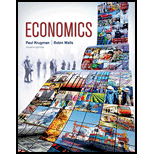
Concept explainers
The required answers according to the given data.
a. The level of private savings.
Explanation of Solution
Given,
Export is $125 million.
Import is $80 million.
Budget balance is
Investment spending is $350 million.
The formula to calculate net capital inflow is:
Substitute $80 million for IM and $125 million for X.
The formula to calculate private saving is:
Substitute $350 for investment spending,
Introduction:
Open Economy: The economy in which there is no restriction on trade which means that there exists import and export. Such economy is referred to as Open Economy.
Investment spending: All those spending which are done on new physical capital which means that only expenses that increase economy level of physical capital is known as investment spending.
The formula to calculate investment spending is:
Investment Spending = Private Saving + Budget Balance + Net Inflows
Private Saving: It is the saving made by people for the time of emergency or the bad financial conditions.
The formula to calculate private saving is:
Private Saving = Investment Spending - Budget Balance - Net Inflows
Budget Balance: The budget is considered to be balanced when revenue collected from tax and expenditures made by government are equal. When it is deficit it is represented by negative value, when it is surplus it is represented by positive value and in case of balanced budget it is zero.
The formula to calculate budget balance is:
Budget Balance = Investment Spending - Private Saving - Net Inflows
Net Capital Inflow: It is the total amount of incoming of all the financial assets into a country which is then deducted from the total outgoing of financial assets out of a country.
The formula to calculate net capital inflow is:
Here,
- IM is quantity of imports.
- X is quantity of export.
b. The level of investment spending.
Explanation of Solution
Given,
Export is $85 million.
Import is $135 million.
Budget balance is $100 million.
Private saving is $250 million.
The formula to calculate net capital inflow is:
Substitute $135 million for IM and $85 million for X:
The formula to calculate private saving is:
Substitute $250 million for private savings, $100 million for budget balance and $50 million for net inflows.
c. The level of budget balance.
Explanation of Solution
Given,
Export is $60 million.
Import is $95 million.
Investment spending is $300 million.
Private saving is $325 million.
The formula to calculate net capital inflow is:
Substitute $95 million for IM and $60 million for X:
The formula to calculate budget balance is:
Substitute $325 million for private savings, $300 million for investment spending and $35 million for net inflows:
Thus, budget balance is
d. The level of net capital flow.
Explanation of Solution
Given,
Investment spending is $400 million.
Budget balance is $10 million.
Private saving is $325 million.
The formula to calculate net capital inflow that is
Substitute $325 million for private savings, $10 million for budget balance and $400 million for investment spending.
Want to see more full solutions like this?
- Critically analyse the five (5) characteristics of Ubuntu and provide examples of how they apply to the National Health Insurance (NHI) in South Africa.arrow_forwardCritically analyse the five (5) characteristics of Ubuntu and provide examples of how they apply to the National Health Insurance (NHI) in South Africa.arrow_forwardOutline the nine (9) consumer rights as specified in the Consumer Rights Act in South Africa.arrow_forward
- In what ways could you show the attractiveness of Philippines in the form of videos/campaigns to foreign investors? Cite 10 examples.arrow_forwardExplain the following terms and provide an example for each term: • Corruption • Fraud • Briberyarrow_forwardIn what ways could you show the attractiveness of a country in the form of videos/campaigns?arrow_forward

 Principles of Economics (12th Edition)EconomicsISBN:9780134078779Author:Karl E. Case, Ray C. Fair, Sharon E. OsterPublisher:PEARSON
Principles of Economics (12th Edition)EconomicsISBN:9780134078779Author:Karl E. Case, Ray C. Fair, Sharon E. OsterPublisher:PEARSON Engineering Economy (17th Edition)EconomicsISBN:9780134870069Author:William G. Sullivan, Elin M. Wicks, C. Patrick KoellingPublisher:PEARSON
Engineering Economy (17th Edition)EconomicsISBN:9780134870069Author:William G. Sullivan, Elin M. Wicks, C. Patrick KoellingPublisher:PEARSON Principles of Economics (MindTap Course List)EconomicsISBN:9781305585126Author:N. Gregory MankiwPublisher:Cengage Learning
Principles of Economics (MindTap Course List)EconomicsISBN:9781305585126Author:N. Gregory MankiwPublisher:Cengage Learning Managerial Economics: A Problem Solving ApproachEconomicsISBN:9781337106665Author:Luke M. Froeb, Brian T. McCann, Michael R. Ward, Mike ShorPublisher:Cengage Learning
Managerial Economics: A Problem Solving ApproachEconomicsISBN:9781337106665Author:Luke M. Froeb, Brian T. McCann, Michael R. Ward, Mike ShorPublisher:Cengage Learning Managerial Economics & Business Strategy (Mcgraw-...EconomicsISBN:9781259290619Author:Michael Baye, Jeff PrincePublisher:McGraw-Hill Education
Managerial Economics & Business Strategy (Mcgraw-...EconomicsISBN:9781259290619Author:Michael Baye, Jeff PrincePublisher:McGraw-Hill Education





